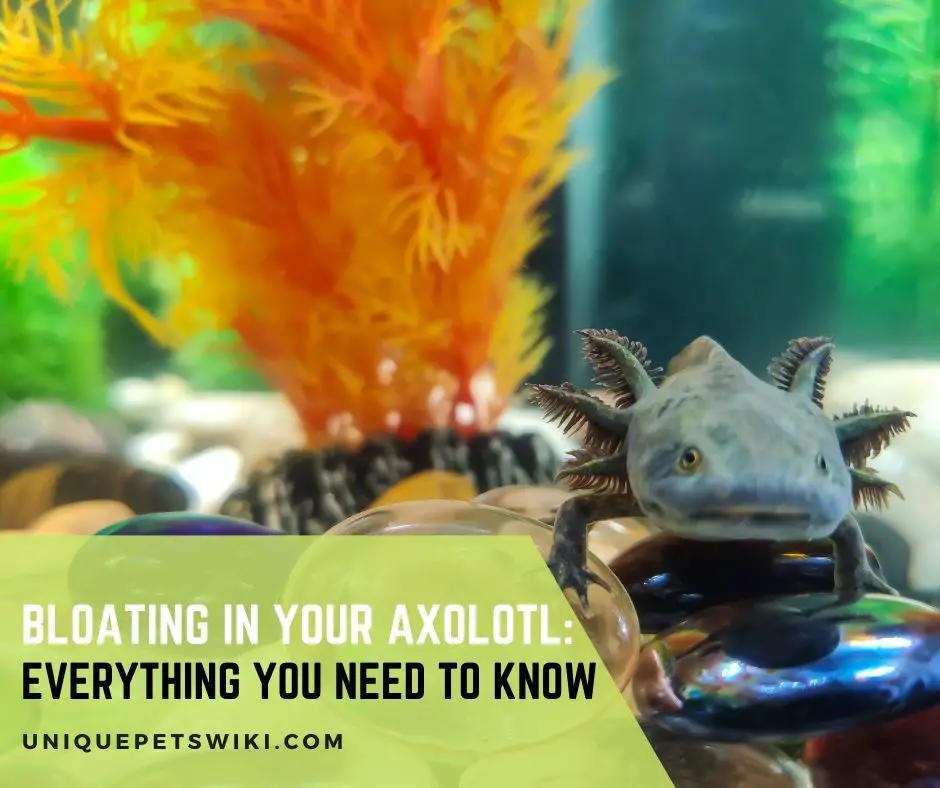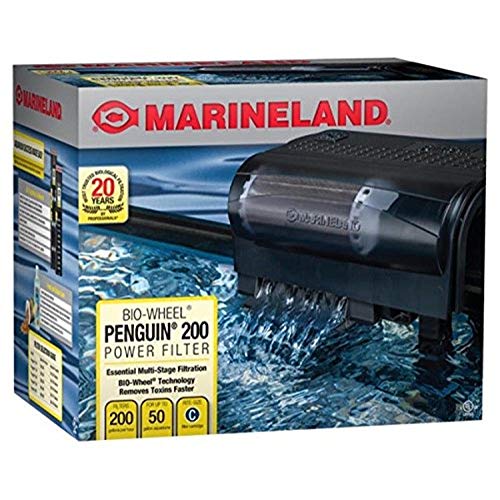Axolotl bloating is a common problem that an axolotl owner is bound to face at some point or the other.
A number of factors can cause bloating in your axolotl. Sometimes, it may be due to overeating and gas entrapment.
At other times, serious issues like infections, disease, impaction, or ingesting some foreign body could be the cause.
In this guide, we will enlist all the reasons behind axolotl bloating as well as ways to treat and prevent it.
Contents
How Do You Know If Your Axolotl Is Bloated
Bloat looks like swelling or edema. Your axolotl’s tummy will appear more rounded than usual.
It may be due to a gas pocket that develops in its abdominal cavity causing the stomach to protrude outwards.
Other symptoms of axolotl bloating, other than a swollen belly, include lack of appetite, lethargy, and hiding or not swimming around. These will of course depend on the cause behind bloating.
As mentioned earlier, axolotl bloating is quite common. Often, it goes away on its own and you need not do anything about it.
Just like humans bloat due to gas entrapment or overeating, axolotls can also overfeed and bloat up.
9 Causes of Bloating in Your Axolotl
There can be numerous reasons behind axolotl bloating. Typically, swallowing or gulping too much air, bacterial infection, parasites, ingestion of foreign body, or improper water temperature could result in it.
Let us consider each of these causes in detail:
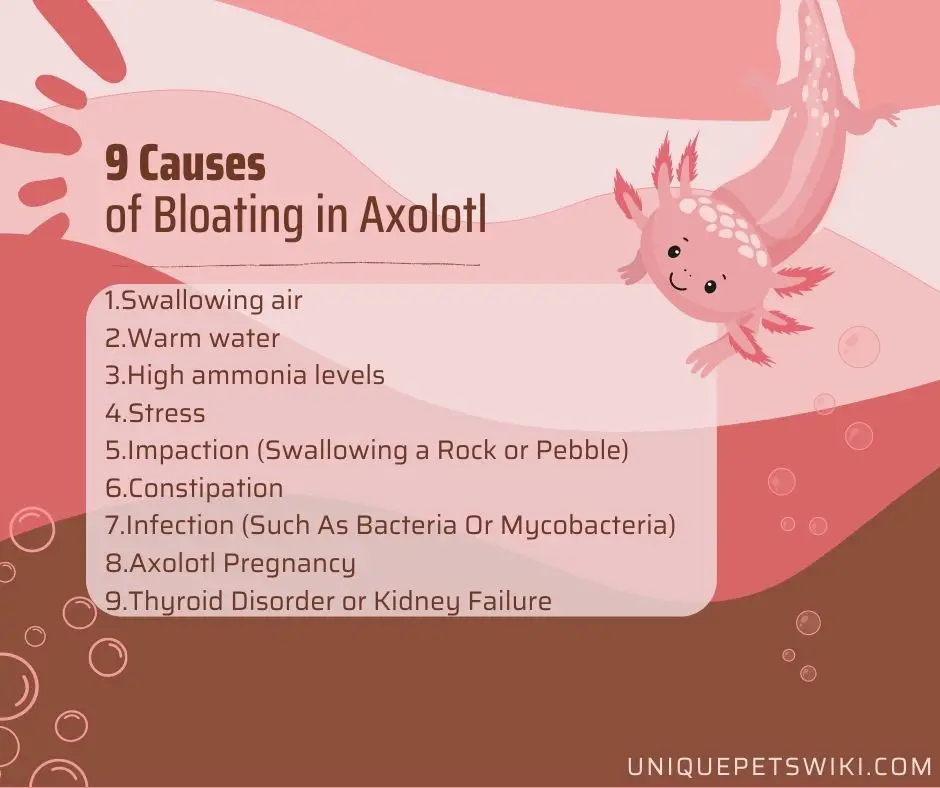
1.Swallowing Air
Axolotls have both gills and lungs for respiration. They usually use their gills to breathe under the water. However, they often come up to the surface of the water to gulp air through their lungs.
If they gulp too much air, then that could result in bloat.
Signs
- You might hear a definite gulping sound from your axolotl. Your pet may repeatedly come up to the surface of the water and gulp a lot of air before going back down.
- Its abdomen may appear swollen or distended.
- Your pet may float on its side often.
Cause
- Typically, poor water parameters cause an axolotl to constantly gulp air. Nitrite spikes are usually the cause behind excess gulping in axolotls.
- A tank that isn’t cycled or one that has a crashed nitrogen cycle could also result in excess gulping behavior in axolotls.
What to do
- Stop feeding your pet.
- Test all water parameters – temperature, ammonia, nitrates, and nitrites.
- If required, move your pet to another tank containing cool, dechlorinated water, temporarily. This will help release excess gas and even cause it to poop.
- Move your pet to a properly cycled tank and observe it.
- If the gulping/bloating continues please contact an aquatic vet.
Also read: How To Cycle Tank For Axolotl: 7 Steps for Beginners
2.Warm Water
Axolotls always prefer cool or cold water with a temperature range of 16-18 degrees C or 60-64 F. Warm water or too hot ambient temperatures could make them bloated, sick, and lethargic.
Signs
- Most axolotls stop eating when the water is too warm.
- Some tend to bloat, become lethargic, and even float on top of the aquarium plants or at the bottom of the tank. If the temperature continues to remain warm, it could even die.
Causes
- In winters, if your home is centrally heated, the tank water could warm up. Likewise, in summers, the hot and humid air could heat up the tank water.
- If you do not monitor your pet’s water temperature, then this could result in a warm tank that, in turn, could cause bloating and other health issues in your axolotl.
What to do
- Check the water temperature. It should be between 60-64 F (16-18 C).
- Add a bottle of refrigerated, dechlorinated water to the tank to cool it down. Please note that this is a short-term fix.
- Use an aquarium water chiller to keep your axolotl cool and comfortable.
Also read: Axolotl Temperature (Tips to Maintain an Ideal Temperature)
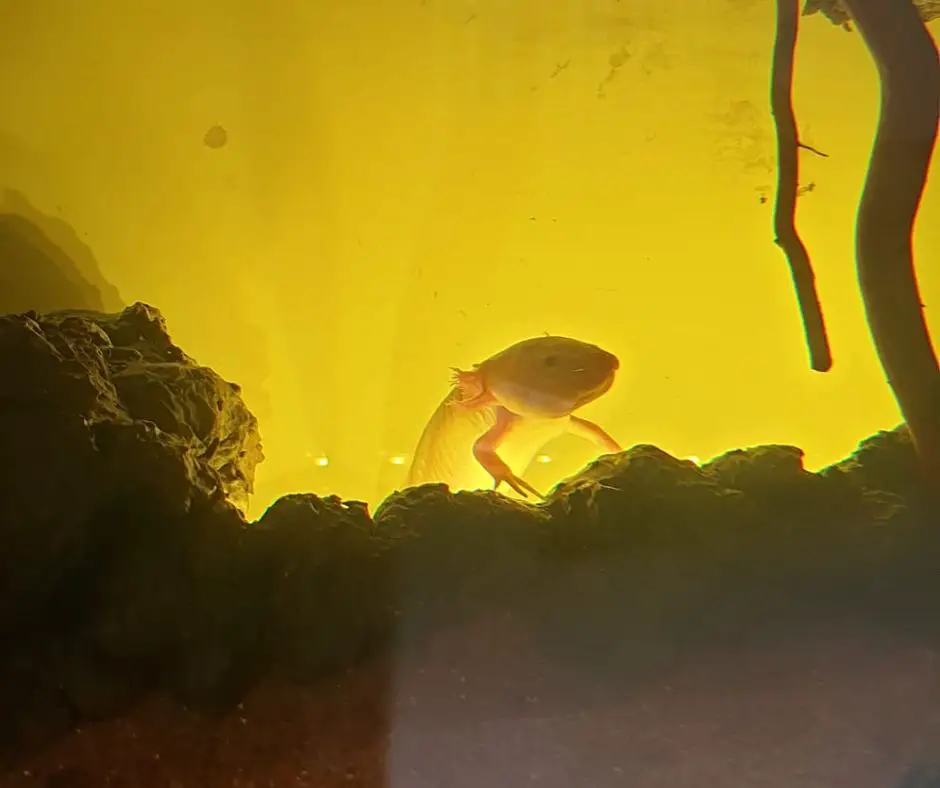
3.High Ammonia Levels
One of the most common husbandry issues that result in axolotl bloating is higher ammonia levels.
The ideal range for ammonia is 0 ppm. Anything above this level is a surefire invitation to health issues in your little pet.
Signs
- High levels of ammonia could start off with your axolotl gasping for air. It may appear to be in pain. Its body might swell up, especially its abdomen.
- You might see reddish marks on its skin.
- Your pet will stop eating entirely.
- It might float or appear lethargic.
- Its gills will deteriorate and its tail might curl.
Causes
- Your tank’s nitrogen cycle might have crashed.
- There are no longer beneficial bacteria to convert ammonia into beneficial nitrates.
What to do
- Transfer your pet to another tank with cool, dechlorinated water. This will help it poop and reduce bloating.
- If needed, refrigerate your pet. You may also treat it to a tea bath.
- Clean the crashed, contaminated tank and set up a nitrification mechanism. Test the water parameters before transferring your pet back into the tank.
- Prevent water contamination through regular (50-70%) water changes. Avoid over-feeding and over-stocking axolotls in the tank.
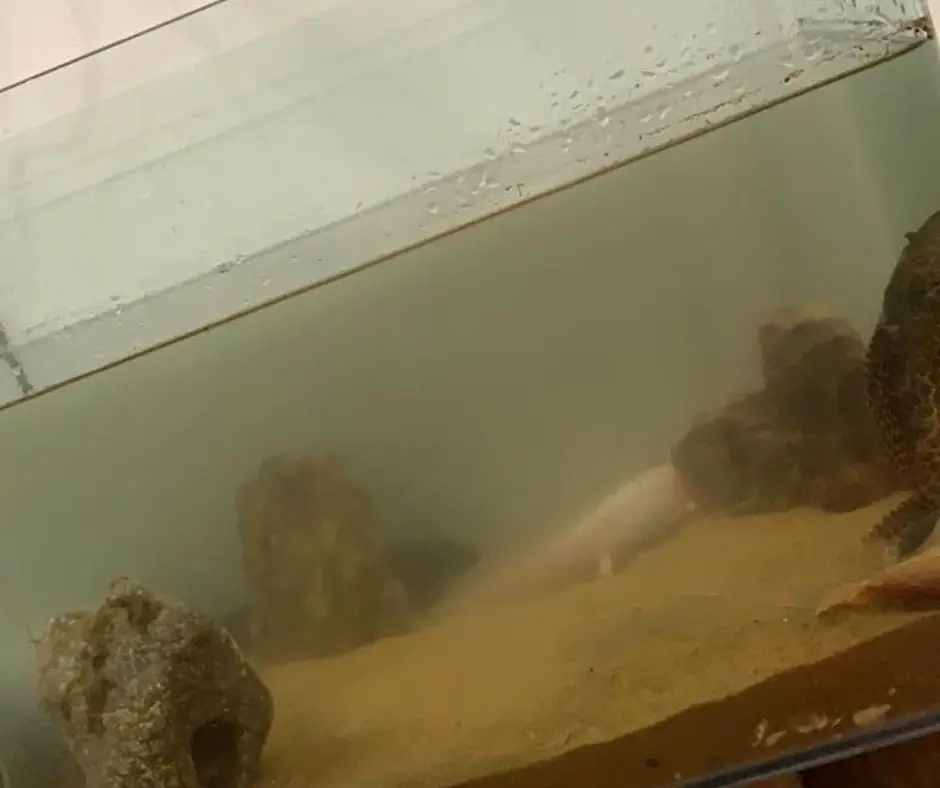
4.Stress
When an axolotl becomes stressed, it can impact its digestion and result in a bloated belly. Poor tank conditions or a crashed nitrogen cycle, and improper water changes are some of the causes.
Signs
- Bent gills
- Lack of appetite
- Not swimming around – being lethargic, hiding, or simply floating
- Gulping air frequently
- Distended stomach
- Discolored skin
- Swimming around uneasily
Cause
- The tank may be dirty or contaminated. This can result in harmful bacteria and affect its appetite.
- If you feed your pet erratically, that too could result in stress.
- Axolotls are nocturnal beings – too much light over their tank could be a major cause of stress.
- Another tank mate (a fish or another axolotl) may be stressing/bullying it.
What to do
- Keep a regular tank cleaning and feeding schedule
- Monitor the levels of bacteria and ammonia in the tank
- Avoid overstocking axolotls. Make sure the tank has adequate space for all the inhabitants.
Marineland Penguin Bio-Wheel Power Filter
- WITH ROTATING BIO-WHEEL: Patented Bio-Wheel technology provides excellent wet/dry biological filtration
- MULTI-STAGE FILTRATION: Delivers mechanical, chemical and biological aquarium filtration to maintain a clean aquatic environment
- MARINELAND FILTRATION PRODUCTS: Count on Marineland brand for the most reliable, technically advanced aquariums and accessories on the market
- COMPATIBILITY: Use with Marineland Rite-Size Filter Cartridges (see individual filter for sizing recommendations)
- FIVE SIZES: Available in 75 GPH, 100 GPH, 150 GPH, 200 GPH and 350 GPH sizes
Last update on 2022-12-30 / Affiliate links / Images from Amazon Product Advertising API
5.Impaction (Swallowing a Rock or Pebble)
Impaction is a serious condition in axolotls. It results in an intestinal blockage and prevents your pet from pooping.
Signs
- Struggling to poop.
- Severe constipation
- Total lack of appetite
- Signs of pain, distress, discomfort
- Floating around or hiding
Cause
- Impaction in axolotls occurs typically due to swallowing sand/gravel/rock/pebble or some other foreign object.
- This results in a swollen abdomen as your pet is unable to pass the foreign matter out through defecation.
What to do
- Transfer your pet to the refrigerator in a container with cool, dechlorinated water. This will encourage a bowel movement.
- A tea bath can also help.
- If the axolotl continues to be impacted, consult an aquatic vet. They may take X-rays to see what the blockage is. Sometimes it could be too big to pass on its own and may require surgery.
6.Constipation
A constipated axolotl is unable to have a bowel movement. This too can cause its tummy to appear swollen.
Signs
- If an axolotl is constipated, it will stop passing stools.
- It may appear to be in discomfort and might stop feeding.
Causes
- Typically, food is the cause of constipation in axolotls. If you feed it sinking pellets, they could be difficult to digest.
- When you put your sinking pellets or unsoaked feed in the aquarium, with time, even in the stomach, they tend to absorb lots of water. This results in trapped air and gas in your pet’s abdomen due to the fermenting of food, and subsequently, bloating.
What to do
- The good news is axolotl constipation is treatable.
- Do not feed your pet while it is constipated, as not only will it not eat, it might even compound the problem if it does eat.
- Fridging can prove very beneficial for an axolotl suffering from constipation as the cool water can encourage bowel movement.
Check out: Axolotl Constipation: 8 Symptoms and 3 Ways Treatment
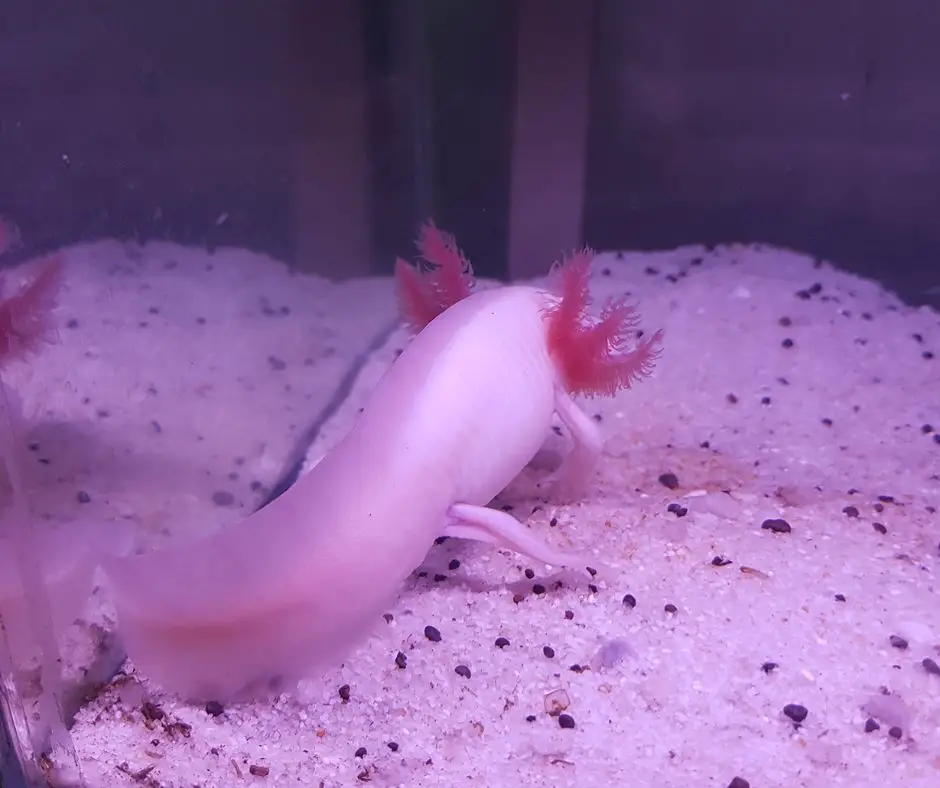
7.Infection (Such As Bacteria Or Mycobacteria)
Bacterial infection due to Aeromonas bacteria or mycobacteria could result in a lack of appetite, while also causing the axolotl to retain fluid and swell up.
Signs
- Lack of appetite
- Redness of limbs and bleeding sores.
- Curled or deteriorated gills
- Skin discoloration
- Lack of movement
Causes
- Poor water parameters
- Overcrowded tank
- Stress
- A contaminated or dirty tank
- Unsterile plants
What to do
- Your pet will need veterinary help. With proper medications and antibiotics – usually administered via injection – your pet will feel better.
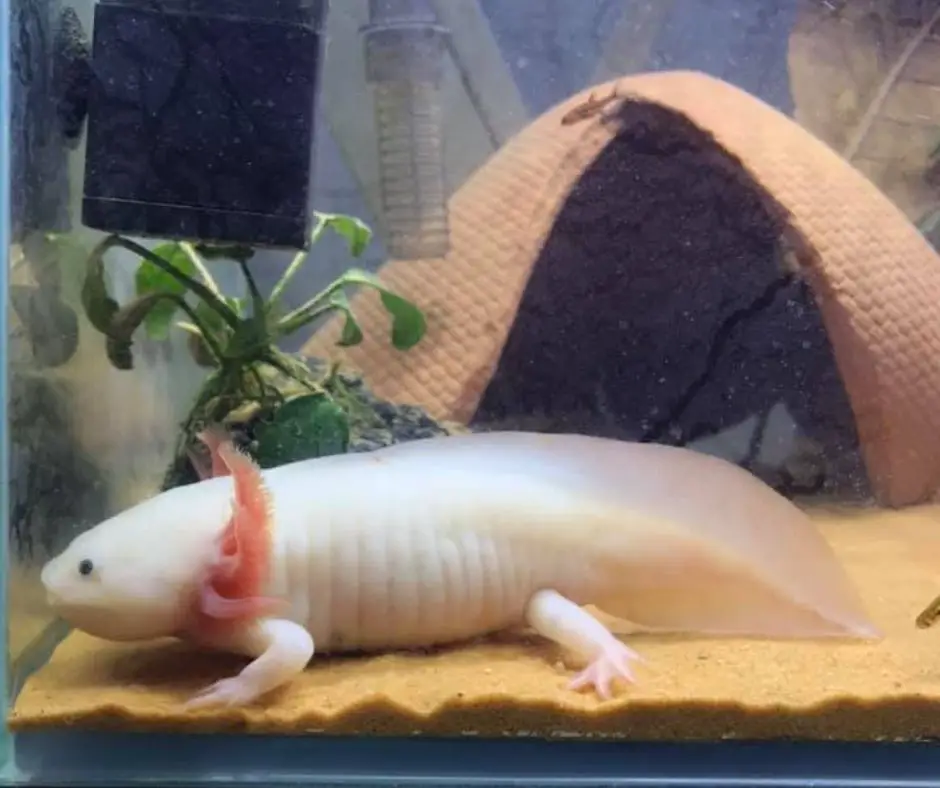
8.Axolotl Pregnancy
During Axolotl Pregnancy, the female axolotl’s lower abdomen will appear swollen.
If you have housed a male and female axolotl together, chances are that she could pick up the spermatophore that the male has deposited externally.
Signs
- Axolotl pregnancy leads to a teardrop shape in the female axolotl. It will become more pronounced during ovulation
- She will swim around the tank when is close to laying eggs.
- Axolotls spawn quickly, so you’ll see the eggs first.
What to do
- Get an aquatic vet to confirm the pregnancy.
- You do not have to do anything different. However, you may choose to remove the eggs or breed them.
Check out: Axolotl Breeding: Everything You Need to Know
9.Thyroid Disorder or Kidney Failure
The thyroid and kidneys of an axolotl help regulate its fluid balance. Any disorder in these can result in health issues such as bloating.
Signs
- Edema or swelling
- The entire body may appear to balloon outward due to fluid retention
- Lack of appetite
- Lethargy and malaise
Causes
- If an axolotl’s thyroid gland or kidneys are not functioning properly, it could lead to water retention and buildup of fluid, resulting in bloat.
- Causes for kidney failure in axolotls are thought to be possibly due to underlying disease, genetics, or poor diet.
What to do
- Kidney failure in axolotls is not treatable.
- Please contact an aquatic veterinarian to provide symptomatic relief to your pet. This includes the use of a syringe to draw the excess water out.
- If bloating continues, your vet may want to run some tests to see if there is another cause such as bacterial or fungal infections, or even some rare cancers.
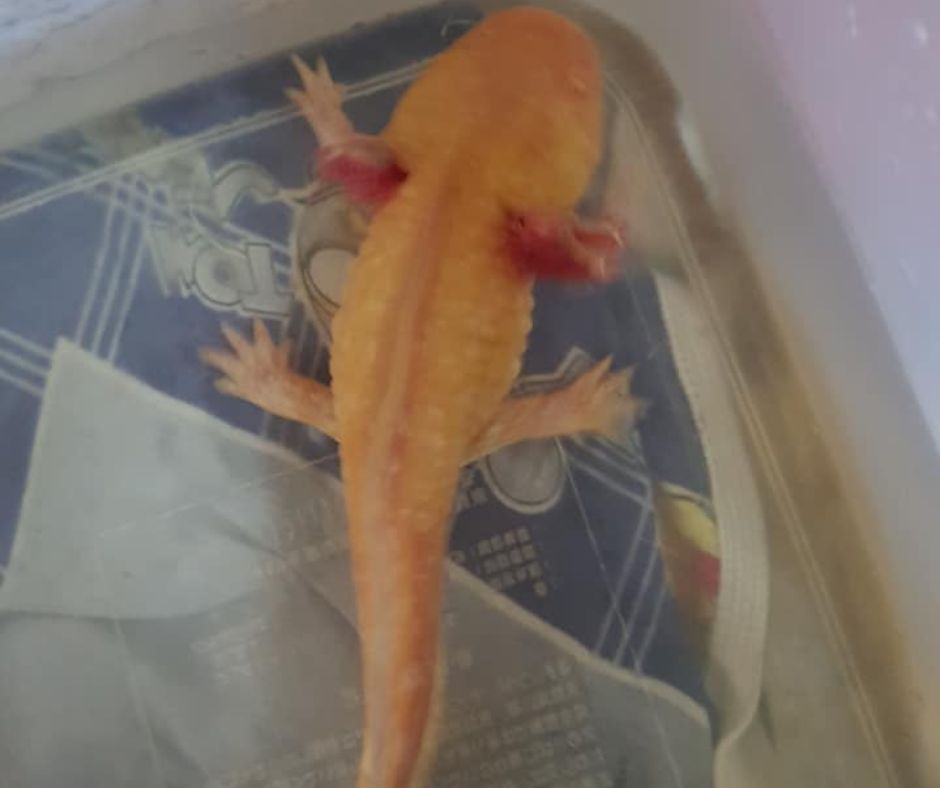
How to Prevent Bloating in Your Axolotl
To prevent bloating in axolotls, you must eliminate the root causes described above. Here are some steps you can take:
1.Feed the Right Type and the Right Amount of Food
Remember, axolotls often eat things they shouldn’t. So please make sure to keep the tank free of things they might ingest.
- Never attempt to forcefully feed your pet, especially while it is bloated.
- Always follow appropriate eating intervals. Most adult axolotls can be fed 2-3 times a week. Juveniles or baby axolotls need more feedings – about once a day.
- Remove all of the uneaten food from the tank, otherwise, it could pollute the water and lead to bacterial/fungal infections.
- Feed the right foods to reduce the risk of thyroid and kidney disease. When in doubt, seek the advice of an aquatic vet.
Check out: 5 Best Axolotl Commercial Food
2.Maintain Proper Tank Conditions
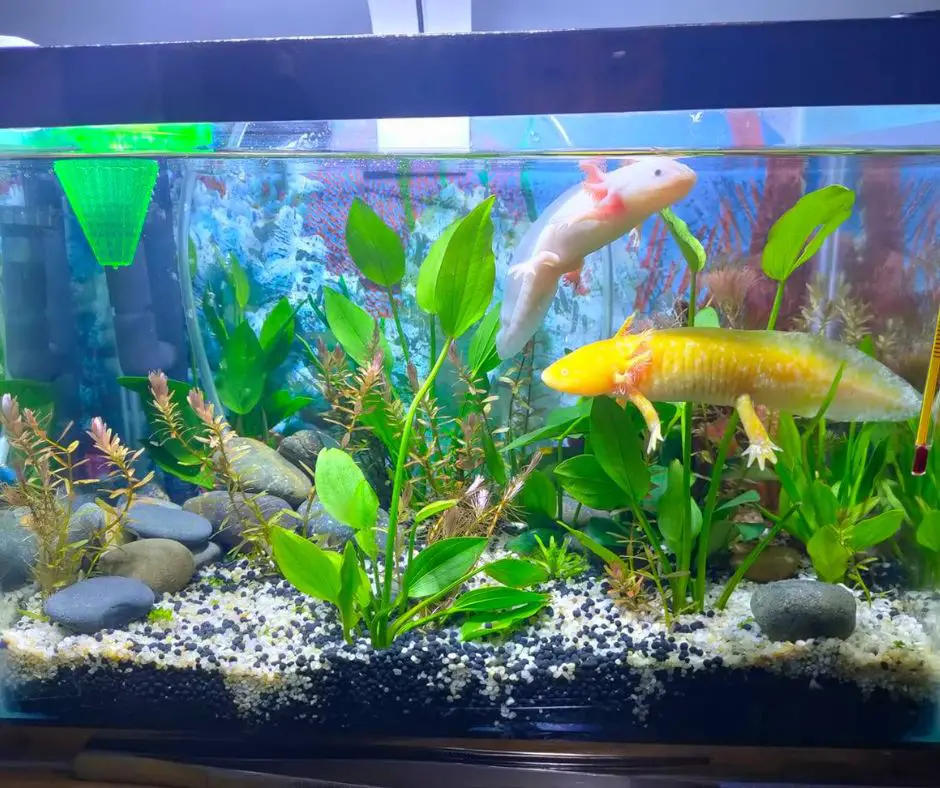
Proper water parameters and tank conditions are very important to ensure your pet thrives.
- Tank – Make sure the tank is large enough for all the inhabitants. One axolotl needs at least a 20-gallon size tank. Two axolotls should be placed in a tank no smaller than 70-100 gallons. Also, place plenty of large rocks, bridges, caves, and other items they can hide under and shelter from the light outside.
- Temperature – Keep the water temperature between 16-18 deg C or 60-64 F. If needed, use an aquarium chiller.
- Substrate – Avoid small gravel which axolotls could swallow resulting in constipation and impaction. Aquarium-safe sand with large gravel is generally safer compared to pebbles which axolotls love to swallow. If you want to add rocks to your axolotl’s tank, make sure they are larger than your pet’s head.
- Water conditions – The ideal water pH is between 7.4 and 7.6. Use dechlorinated water only. Make sure ammonia is always 0 ppm and nitrates less than 40 ppm. Test the water regularly and make 50-70% water changes every few days.
Check out: Full Requirements & Water Conditions for Axolotl in Captivity
3.Clean the Tank Regularly
Keep the tank clean and ensure optimum water parameters at all times. Dirty water will cause harmful bacteria and fungi and could even stress your pet.
- Schedule weekly spot cleaning of the tank.
- Make regular (70%) water changes each week.
- Deep clean the tank every 6 months with gravel siphoning.
- Use a good filter.
Also read: How to Keep An Axolotl Tank Clean
BAOSHISHAN Aquarium Chiller
- Well for 32’’ Big Fish Tanks -- Better maintain a constant temp for big fish tanks less than 42gal, about 32’’/80cm, our chiller can reduce water temperature and drop up to 8-10F in general, less water for lower water temp
- Essential for Hydroponics and Aquarium -- High-efficiency freon free compressor provides more rapid and stable cooling than small fans, using r134a refrigerant, circulating cooling without pollution and do not need to be supplemented. Can well control the ideal water temp at 68-78F/20-26°C, necessary for creating healthy roots and a good harvest
- Keep Your Coral Reef Alive -- Inner pure titanium evaporator ensures that the chiller has effective corrosion resistance while achieving the most effective heat exchange, for both fresh and salt water, can fully meet the sensitive temp needs of your coral farming
- Fast Heat Dissipation -- Two built-in fans and a large number of heat dissipation holes on both sides of the machine provide powerful ventilation to dissipate compressor heat well, ensuring compressor can work efficiently for all day long. Note there must be a space of 6''/15cm around the chiller for enough air circulation and efficient cooling
- One Year Warranty -- BAOSHISHAN take the responsibility of one year warranty for this water chiller, please don’t worry, professional and friendly after-sales team will help you solve any problem, and you only need to enjoy the convenience it brings
Last update on 2022-12-29 / Affiliate links / Images from Amazon Product Advertising API
In Conclusion – Axolotl Bloating
A number of factors can cause axolotl bloating. Sometimes, it may be due to overeating and gas entrapment.
At other times, serious issues like infections, disease, impaction, or ingesting a foreign body could be the cause.
We hope this guide helps you find out the exact cause behind axolotl bloating and also ways to treat and prevent it.
